This is a general question about typesetting paragraphs. I was wondering if it is good (or acceptable) practice to mix two different kinds of paragraph skips in a document, e.g.
- a "real" paragraph skip with let's say a blank line in between paragraphs
- a "small" paragraph skip using only a linebreak
Here is a quick example using a KOMA-script class for convenience:
\documentclass[parskip=half*]{scrartcl}
\usepackage{lipsum}
\begin{document}
This is the beginning of a new thought that deserves a new
paragraph. It will probably stretch out over quite a few lines. The
thought is a bit complex, so while everything that is necessary to
explain it should be kept in one paragraph, it would be nice to have
some additional \textit{within-paragraph} structure.\newline
\lipsum[1][1-4]\newline
\lipsum[1][5-7]
This is the beginning of another thought that deserves a new paragraph.
It will probably stretch over quite a few lines.\newline
\lipsum[2][1-4]
\end{document}
The purist in me would argue that there should be one and only one type of paragraph skip. For what I am currently writing about, this results, however, either in very long paragraphs or very many quite short paragraphs. In the long paragraphs, it becomes hard to quickly identify logical sub-points that belong to the same super-point. The short paragraphs look odd if I stick to the parskip=half* setting and I lose the visual distinction between logical sub-points and new super-points.
I am looking forward to your thoughts and I am sorry if this question is too opinionated for this forum.


Best Answer
I think that it is generally accepted that there should be no blank space between paragraphs. That is a "small paragraph skip" according to your question.
A more pronounced break between paragraphs to the reader indicates a change of topic/emphasis.
The
memoirclass (a superset ofbookandreport) provides means of specifying "anonymous" breaks between paragraphs.I think that it is up to you as the typographer how you want to distinguish between bunches of paragraphs that deal with different aspects of the general topic. The main aim is to help, not confuse, the reader. As shown above you can have differing distinctions between the various paragraph topics depending on how dissimilar they are.